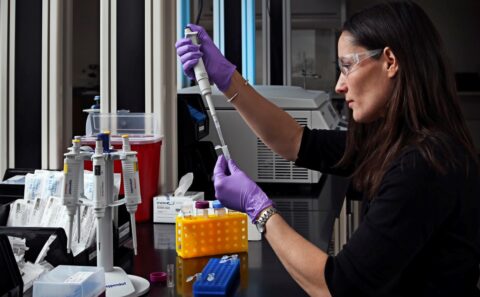Funding for the HealthTech sector is reaching all-time highs, but innovation alone isn´t really helping reduce health care costs. In 2021, according to CB Insights, digital health companies worldwide received more than USD 57.1 billion in investments. According to the Organisation of Economic Cooperation and Development (OECD) estimates, 20% of healthcare spend is wasted globally. So where is the disconnect?
The underlying reasons for this waste include preventable and rectifiable workflow and system inefficiencies and improper care delivery. The innovation ecosystem needs to focus on technologies that increase net productivity (the relative output generated per unit resource required) and therefore optimize costs to increase the affordability of care. There is strong evidence pointing to various ways that Artificial Intelligence (AI) can minimize inefficiencies, optimize time-consuming processes and expand healthcare affordability while decreasing the cost of care. “AI could improve health outcomes by up to 40% and reduce treatment costs up to 50% by improving diagnosis, increasing access to care and enabling precision medicine,” according to Harvard’s school of public health. If implemented correctly at scale, it could save the medical industry upwards of USD 150 billion in costs by 2025 and these cost savings can be passed on to patients. The application of machine learning and artificial intelligence to clinical settings for prevention, diagnosis, treatment, and the improvement of clinical care has been demonstrably cost-effective.
Investors have a crucial role to play in identifying and investing in the solutions that will deliver affordability at scale and support technologies for preventative care, early diagnosis and effective single-treatment approaches. While there are many exciting innovations in the market, selectively leveraging technology to address specific problems along the patient pathway, is critical. Through our work sourcing, investing in and advising companies that are solving some of the biggest health challenges of our time, we have seen first-hand multiple teams with tech-enabled innovations that have affordability at their core. These innovations increase accessibility at scale, lower risks and improve patient care, ultimately lowering costs.
AI-enabled medical imaging for timely diagnosis:
Accurate diagnosis is a fundamental aspect of global healthcare systems. Medical imaging (x-ray, CT scan, MRIs, etc.) is the first line of diagnosing many diseases and monitoring their progression. There are important challenges in modern radiology such as disease complexity, increasing data points and the radiologist workload. At diagnosis, AI algorithms have proven to revolutionize diagnostic pathways when applied to medical imaging, in which the task at hand of interpreting and annotating images are large in volume, repetitive and complex. In fact, 80% of readings are usually normal with the balance 20% requiring prioritization. This is where AI-enabled systems can help optimize workflows to prioritize the 20% abnormal readings that require deeper assessment. Since almost every healthcare system is burdened with high caseloads and a shortage of trained radiologists, predictive analytics by AI-enabled systems can drive faster and more accurate decision-making. AI can scan 1000s of scans in a fraction of a second leading to significantly faster turnaround times by augmenting a radiologist’s workflow. This is particularly critical in developing markets that have an acute shortage of trained radiologists in cities and at the last mile.
An example of this is Qure.AI which uses AI technology to support healthcare professionals in screening for lung, brain and cardiovascular abnormalities faster. Its qXR product, used for chest X-rays, is able to process and return scans in under one minute (versus a few hours to days), aiding in the rapid detection of multiple abnormal findings in the lungs. Qure.AI’s algorithm can reduce radiology workloads, significantly reduce the time to diagnosis and meet Qure.AI’s goal of empowering accessible, affordable and timely care.
AI-enabled digital twins for effective treatment:
Despite significant technological advances in medicine, what is happening inside our bodies often remains a “black box” even until during or after treatment. However, with the application of AI to key challenges across the treatment cycle, innovations can identify the target patient for treatment options, increase the safety of critical procedures, and reduce the chances of readmission. One such AI-enabled innovation is of using digital twins that can drive overall affordability of care by reducing trial and errors in treatment.
Digital twins are used widely across various industries such as airlines to help with the simulation of safety processes or testing of machinery. In medicine, AI-enabled digital twins can simulate and customize elements of the human physiology and create a virtual replica to allow physicians to better understand the unique characteristics of each patient before they begin treatment. This helps to optimize the treatment strategy and makes surgery safer and less risky (50% less failure rate), leading to an overall reduction in the cost to deliver treatment. inHeart is one company that has developed an AI-enabled digital twin of the heart with the aim of advancing the care of patients living with cardiac rhythm disorders. The AI-based platform enables the cardiologist to build a 3D map of the cardiac electro-anatomical model to drive precision and efficiency during treatment. The solution can reduce procedural times and increase workflow productivity, reducing errors both in determining treatment options and during surgery. Increased procedural success rates reduce follow-up costs for patients, providers and payers.
AI-enabled real-world evidence for post-treatment analysis:
At the final point in the patient pathway, efficient post treatment monitoring and development of new therapies requires access and analysis of real-world evidence. But access to and the time required to interpret real-world data is the greatest hindrance to make informed decisions at the right time for the right patient. Considering the large amount of real-world data required, AI can automate the monitoring and interpretation of millions of data points covering patients’ diseases, socio-economic environments, drug prescriptions and dosages, impact on the patients’ health and outcomes to provide improved post-treatment analysis. This results in the development of better treatment options as well as new innovations that can improve patient care and recovery, while also enabling a greater understanding of treatment effectiveness and outcomes. This leads to significant cost-savings.
In the mental health space where very little real-world data exists and there are few clinical biomarkers to objectively measure patient improvements, Holmusk’s database of more than one million behavioural health patient data points offers real-world evidence of whether treatments are effective, and reduces trial and error in treatment, leading to lower costs. With more than 970 million people worldwide suffering from mental illness and substance use disorders Holumsk’s AI-backed analytics offers a significant potential for impact.
Bringing these innovations to market:
Most investors in the past have seen new innovations and affordability in isolation. But we strongly believe that some technologies and innovations, when applied to the right problems can also drive significant affordability in healthcare.
AI is just one of the many technologies changing healthcare, but how it can be applied to solving key challenges across the patient pathway will demonstrate the success of the solution. And it is in our hands as investors to help drive this change, which can have an outsized impact on the health and well-being of populations worldwide.




